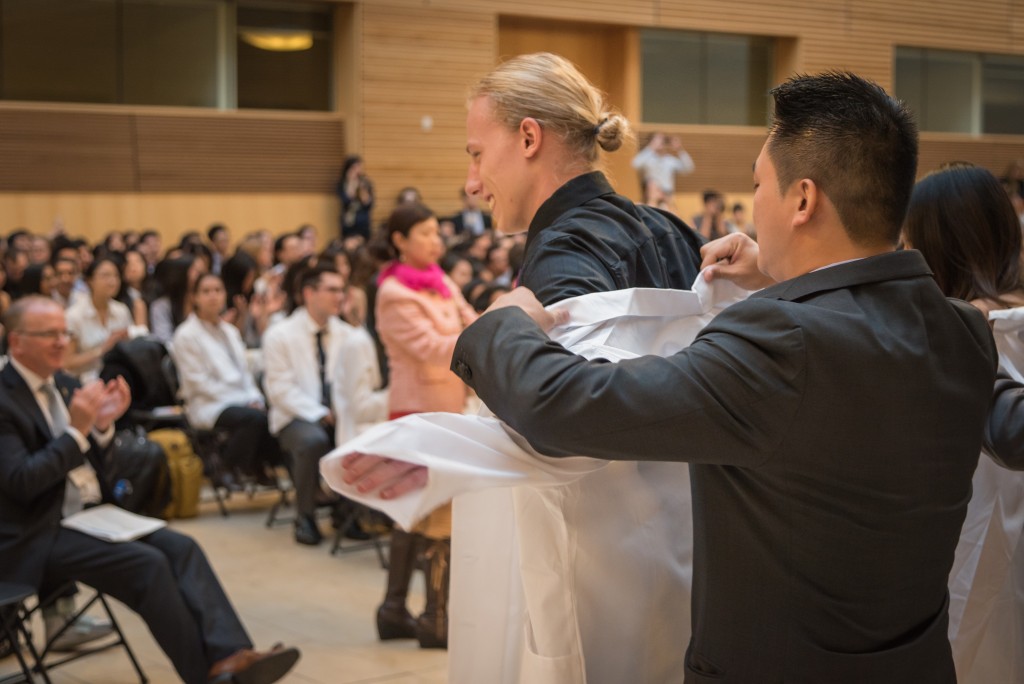Our Director of Communications & Marketing, Jimi Galvão, was curious to learn more about why pharmacists wear white coats. He set out to learn more about the origins of and meaning behind the white coat. Here’s what he learned…
Each year, the Faculty celebrates incoming classes with an event that centres on an important article of clothing for pharmacists and health care professionals the world over: the white coat.
The White Coat Ceremony is an event that brings first year students together to take part in the recital of and reflection on the Faculty’s Pledge of Professionalism, an oath that outlines core values and commitments expected of each pharmacy student relating to patient care and ethical practice. White coats are presented to the students before they recite the pledge, and the act of receiving one symbolizes their acceptance into the ranks of not only the Faculty but the profession of pharmacy as a whole.
Having been with the Faculty for almost five years now, I’ve had the pleasure of being present at many of these ceremonies. And it’s always great to see the pride beaming from the faces of our students and their families. But something struck me as I started thinking about this year’s event. I knew very little about the origins of and meaning behind white coats. When were they first worn? Why are they white and not another colour? Did doctors wear them first? My curiosity sent me on a quest to learn more.
Origins
When I Googled “white coat” I was amazed at how many hits appeared (more than 58 million). And almost as many hits (more than 52 million) appeared when I searched for “history of the white coat.” In general, the white coat originated in the field of medicine and didn’t turn up until the late 1800s. Before being worn by doctors, white coats weren’t white at all. They were beige and covered the arms and torsos of scientists working in labs. When physicians adopted them as part of their professional attire, they were black. According to Andre Picard, author of “Why do physicians wear white lab coats?,” physicians “dressed in black to reflect the sombre nature of their work.” Dr. Mark S. Hochberg, author of “The Doctor’s White Coat–an Historical Perspective,” offers another possibility. He explains that “until the late 19th century seeking medical advice was usually a last resort and frequently a precursor to death.”
Black was replaced in the late 19th century when physicians began incorporating science into their practice, which resulted in advances in the efficacy and reputation of medicine overall. The changes brought about the demise of hospitals being associated with death and despair as recovery rates for patients increased. The revolutionary new direction for medicine called for a new look and the colour white, with its various positive meanings and connotations, was chosen for that look.
Meanings
White has many meanings, but several key connotations include purity, cleanliness, light, hope, safety and goodness. Valerie A. Jones, author of “The White Coat: Why not Follow Suit?,” adds that the colour white also “symbolizes seriousness of purpose” and explains that the white coat “serves as a symbolic barrier that maintains the professional distance between physician and patient.” Jones goes on to say that it is “a cloak of compassion.”
Aside from deep philosophical meanings, I encountered a few practical applications as well. The author of “White Coat Ceremony: Origins and Meaning of the Clinician’s Uniform” explains that white doesn’t “fade when washed at high (germ-killing) temperatures.” White also allows for the quick spotting of stains.
Onward
And so, the newly envisioned white coat was adopted in the medical community as accepted professional attire. Surgeons were among the first to wear them. Then came physicians practicing in hospitals, followed by GPs. By the year 1915, the wearing of white coats was wide spread, with most pharmacists wearing them by the late 1950s.
Today, white coats continue to be worn but there is much debate as to whether or not they should be. Picard writes that “one in eight doctors now wears a white lab coat, according to a U.S. study” and that “one of the reasons physicians have abandoned the traditional garb is that they feel the visual symbol of hierarchy impedes patient care.” He also points to the cost of having white coats cleaned (hospitals used to launder them for free but now only offer this service for scrubs) and the appropriateness of white coats in teamwork environments as other reasons.
At the Faculty’s Pharmacists Clinic, white coats are not worn. “Our clinicians wear name tags but not lab coats to demonstrate our view that a consultation between a pharmacist and patient is a meeting of experts,” says Barbara Gobis, director of the Pharmacists Clinic. “The pharmacist has expert knowledge about drug therapies and the patient is the expert on their own beliefs, values, daily routines and behaviours.”
All that being said, white coats are not totally unwelcome. According to Picard, “surveys show that the majority of patients like the white coat, largely because it helps them figure out who’s who, something that is impossible where every health worker wears scrubs or street clothes.”
So what does the future hold for the white coat? It’s unclear, at best, but for the time being the white coat is an extremely important part of what our students experience at UBC Pharm Sci. And there’s far more to the history of white coats and how they’re perceived today than my allotted word count will allow. To learn more, I strongly encourage you to read the following articles that I referenced and do some Googling of your own. – Jimi Galvão
Why do physicians wear white lab coats?
Andre Picard
The Doctor’s White Coat–an Historical Perspective
Mark S. Hochberg, MD
The White Coat: Why not Follow Suit?
Valerie A. Jones
White Coat Ceremony: Origins and Meaning of the Clinician’s Uniform
What should pharmacists wear?
Lin-Nam Wang
Keep an eye out for the next issue of Discover, coming soon! Are you subscribed to our publications?





 Follow
Follow